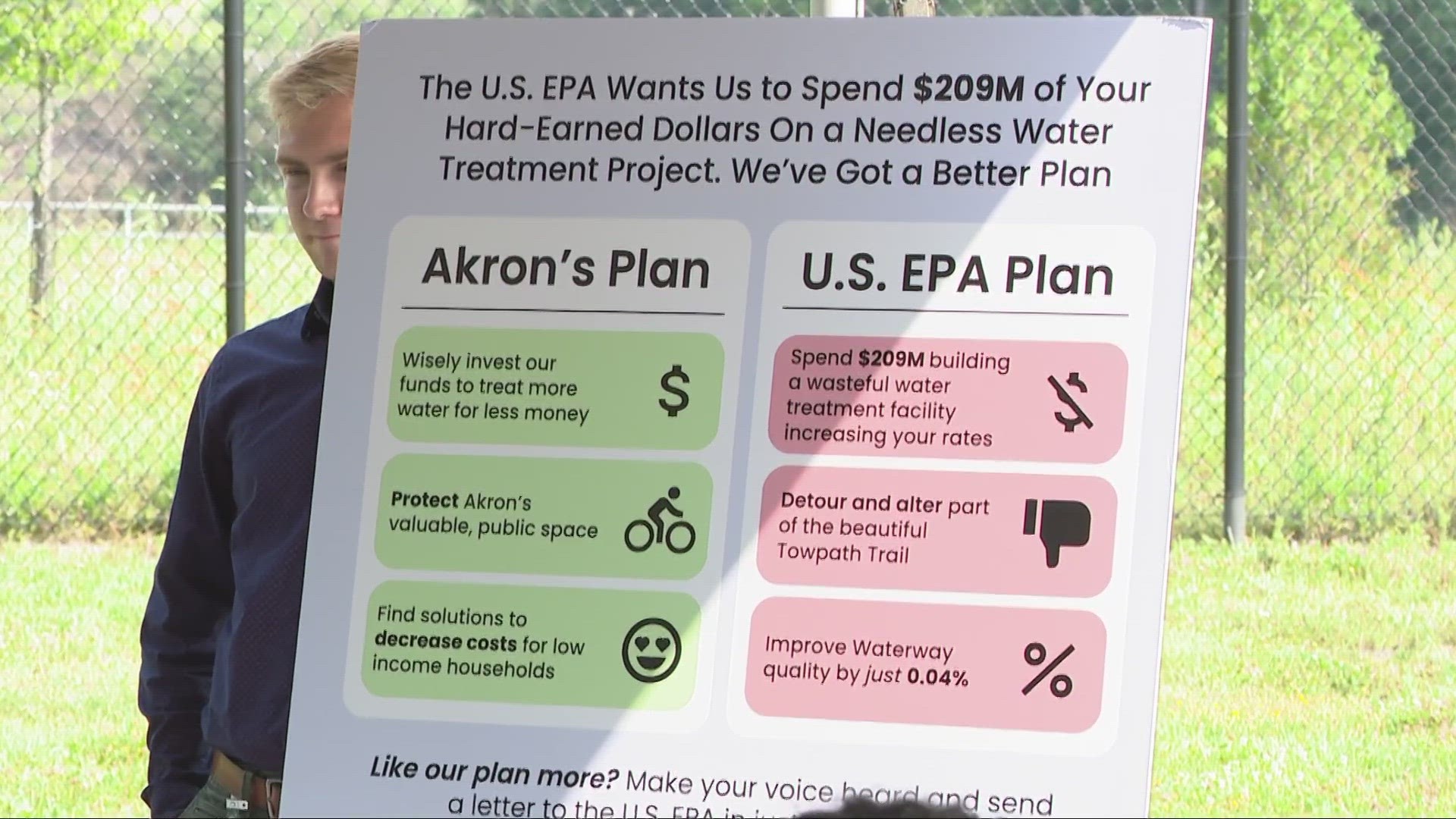AKRON, Ohio — Akron Mayor Dan Horrigan announced the city “has begun a formal dispute resolution process with the U.S. EPA over the proposed fourth amendment to the consent decree.” Specifically, it is asking to back out of an over $200 million project that would only help treat sewage water in a limited capacity, but with that limited capacity would come a major sewage rate hike of 20% if the project would have to move forward.
The EHRT or Enhanced High-Rate Treatment Facility would be added onto Akron's wastewater treatment facility, near mile 13 of the Towpath Trail through town. What is now green space with a trail and a stream running through would turn into a large concrete building designed to treat overflow sewage water at the cost of more than $200 million to build, plus additional funds for upkeep.
Horrigan and his administration have come out against building the EHRT. The problem is it's part of a consent decree agreement between the EPA and the city that's been in place since 2007, with the goal of reducing the amount of raw sewage going into the Little Cuyahoga and flowing into the Cuyahoga River.
"We've put over $100 million dollars in the plant over the last five years to achieve this, so I guess the long/short of it is, we'd love to spend that $209 million dollars on other projects, especially on water," Chris Ludle, Akron's Director of Public Service said.
The city says it has suggested "alternative projects" that they say would cost less than the EHRT "and more significantly improve the quality of our waterways."
You can view Akron’s proposal by exploring the document below…
“The U.S. EPA and the Department of Justice would like our residents and ratepayers to pay over $200 million to build a facility that would only be used at most three times per year,” said Akron Mayor Dan Horrigan. “The benefit of this building is almost non-existent. Meanwhile, after we complete the Northside Interceptor Tunnel, Akron will already be capturing and treating 99% of all wet weather flows. That means over 2.3 billion gallons of water which previously went unchecked back into our waterways will now be treated. This is a massive environmental feat and one we all should be incredibly proud of. But it has come with a cost. The price tag for these improvements is already at $1 Billion. When compared with the amazing work that we’ve done so far and how much we’ve improved our waterways, I cannot justify an additional $200+M for nearly no benefit. This is complete agency overreach and quite frankly, I know this community is tired of it. Today, I am imploring the U.S. EPA to reconsider our proposal to eliminate the EHRT and move forward with our alternative projects. I am asking our community to rally together and make their concerns known to the EPA.”
Akron says modeling data shows if the city has to build the EHRT, sewer rates would have to be raised 20$ more than if the city is allowed to move forward without the EHRT.
The city has offered four alternative projects (listed below), which they say would only total about a quarter of the cost of the EHRT:
- Reduce the typical year discharge to 62 million gallons by treating wastewater at the existing Cuyahoga Street facility
- Sewer the Village of Peninsula in the heart of our National Park
- Conduct the necessary studies to begin the process of providing sanitary sewer service to the Sawyerwood neighborhood of Springfield Township
- Address sanitary sewer overflows to Springfield Lake from the Village of Lakemore
“The last three projects are designed to address persistent, daily bacteria loadings to the Cuyahoga River watershed that threaten recreational uses of local waterways from the Springfield Lake Outlet all the way to the Cuyahoga Valley National Park,” according to the city. “Conversely, as of today’s press conference, the City of Akron has not had a single overflow at the OCIT site in 498 days, meaning over the last year, the EHRT would not have been activated at all and would have had no impact on improving our waterways.”
The city says Akron has completed 24 of the 26 projects listed in the federal consent decree with progress being made on the 25th project – the Northside Inceptor Tunnel.
Akron leaders have filed paperwork with the EPA to see if they can skip the EHRT project because of the wastewater improvement projects they've already implemented since 2007. The EPA has 45 days to respond.
A U.S. EPA spokesperson said they do not comment on ongoing enforcement negotiations.
MORE FROM 3NEWS...
Want to be among the first to know the most important local and national news? You can download the free WKYC app and get the latest updates sent to your phone: Android, Apple.


